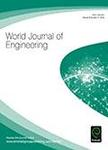版权所有:内蒙古大学图书馆 技术提供:维普资讯• 智图
内蒙古自治区呼和浩特市赛罕区大学西街235号 邮编: 010021

作者机构:Jaypee Univ Informat Technol Dept Elect & Commun Engn Waknaghat India Chandigarh Coll Engn & Technol Dept Elect & Commun Engn Chandigarh India
出 版 物:《WORLD JOURNAL OF ENGINEERING》 (World J. Eng.)
年 卷 期:2018年第15卷第4期
页 面:498-504页
学科分类:12[管理学] 1201[管理学-管理科学与工程(可授管理学、工学学位)] 08[工学]
主 题:Cumulative distribution function Maximal ratio combining Multiple-input multiple-output Orthogonal space time block codes Symbol error rate Weibull fading
摘 要:Purpose This paper aims to exploit an orthogonal space-time block code (OSTBC) and maximal ratio combining (MRC) techniques to evaluate error rate performance of multiple-input multiple-output system for different modulation schemes operating over single- and double-Weibull fading channels. Design/methodology/approach The authors provided a novel analytical expression for cumulative distribution function (CDF) of double-Weibull distribution in the form of Meijer-G function. They also evaluated probability density function (PDF) and CDF for single- and double-Weibull random variables. CDF-based closed-form expressions of symbol error rate (SER) are computed for the proposed systems design. Findings Based on simulation and analytical results, the authors have shown that double-Weibull fading which shows the cascaded nature of channel gives significantly poor SER performance compared to that of single-Weibull fading. Moreover, MRC offers an improved error rate performance compared to that of OSTBC. As the fading parameter increases for any modulation technique, the required signal-to-noise ratio (SNR) gap between single- and double-Weibull fading decreases. Finally, it is observed that the analytical results are a good approximation to simulation results. Practical implications For practical implication, the authors use a number of antennas at the base station, but solely to maximize performance, one can use receive diversity, i.e. MRC. Originality/value Using higher-order modulation (i.e. 16-QAM), 4 and 1 dB less SNR is required at high and less fading, respectively, in single-Weibull fading as compared to double-Weibull fading. Hence, at higher-order modulation, double-Weibull channel model performs better as compared to lower-order modulation.